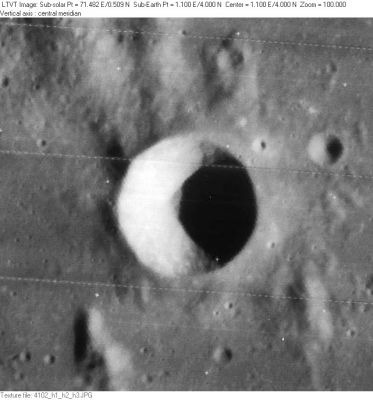Chladni
Contents
Chladni
|
Lat: 4.0°N, Long: 1.1°E, Diam: 13 km, Depth: 2.63 km, Rükl: 33 |
Images
LPOD Photo Gallery Lunar Orbiter Images Apollo Images
- The search for possible appearances of crater Chladni on orbital photographs made during one or more missions of the Apollo project is a worthwile pastime. A candidate mission is Apollo 10, in which several oblique north-looking photographs were made of the nearby eastward located Triesnecker rille system.- DannyCaes May 29, 2010
- Apollo 10's AS10-32-4734 shows an oblique west-northwest looking view of Chladni during local sunrise. The crater near the frame's lower right corner is Triesnecker.
- Apollo 10's AS10-32-4821 shows Chladni in the lower right quadrant of the frame. The large eroded craters near Chladni are the couple of Murchison and Pallas.
- Chladni was also captured on several oblique north looking Fairchild camera frames made during the mission of Apollo 16. One of those frames is AS16-M-0842, in which bowl shaped crater Chladni is detectable near the central part of the curved horizon.
Research orbital Apollo 10 and Apollo 16 photography: Danny Caes
Maps
(LAC zone 59C4) LAC map Geologic map AIC map
Description
Description: Wikipedia
Additional Information
- Depth data from Kurt Fisher database
- Arthur, 1974: 2.63 km
- Westfall, 2000: 2.63 km
- Viscardy, 1985: 2.63 km
- Cherrington, 1969: 2.1 km
- Included in ALPO list of bright ray craters
- Included in ALPO list of banded craters
Nomenclature
- Named for Ernst Florens Friedrich Chladni (November 30, 1756 - April 3, 1827), a German physicist. In 1794, Chladni published a book in which he proposed that meteorites have their origins in outer space. This was a very controversial statement at the time, and with this book Chladni also became one of the founders of modern meteorite research. One of Chladni's most well known achievements was inventing a technique to show the various modes of vibration in a mechanical surface. Chladni's technique, first published in 1787 his book, Entdeckungen über die Theorie des Klanges, consists of drawing a bow over a piece of metal whose surface is lightly covered with sand. The plate is bowed until it reaches resonance and the sand forms a pattern showing the nodal regions . Since the 20th century it has become more common to place a loudspeaker driven by an electronic signal generator over or under the plate to achieve a more accurate adjustable frequency. Variations of this technique are commonly used in the design and construction of acoustic instruments such as violins, guitars, and cellos.
- This crater, known as Triesnecker A to Beer and Mädler and their follows, was Catalog Number 865 in Mary Blagg's Collated List.
- In the original IAU nomenclature of Named Lunar Formations the name Chladni was substituted, following a suggestion made by Julius Schmidt when preparing Lohrmann's charts for publication.
- A very small formation on the western inner slope of Chladni (very near the floor of the crater) seems to be known as the Flaming Heart Moon Fish (source: Moon Zoo). - DannyCaes Jan 26, 2016
LPOD Articles
Bibliography
